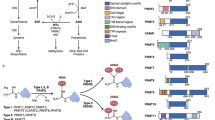Abstract
NAT10 (N-acetyltransferase 10) is a protein with histone acetylation activity and primarily identified to be involved in regulation of telomerase activity. The presented research shows its transcriptional activation by genotoxic agents and possible role in DNA damage. NAT10 mRNA could be markedly increased by using hydrogen peroxide (H2O2) or cisplatin in a dose- and time-dependent way, and the immunofluorescent staining revealed that the treatment of H2O2 or cisplatin induced focal accumulation of NAT10 protein in cellular nuclei. Both H2O2 and cisplatin could stimulate the transcriptional activity of the NAT10 promoter through the upstream sequences from −615 bp to +110 bp, with which some nuclear proteins interacted. Ectopic expression of NAT10 could enhance the number of survival cells in the presence of H2O2 or cisplatin. The above results suggested that NAT10 could be involved in DNA damage response and increased cellular resistance to genotoxicity.







Similar content being viewed by others
References
Lv JJ, Liu HJ, Wang Q, Tang ZW, Hou L, Zhang B (2003) Molecular cloning of a novel human gene encoding histone acetyltransferase-like protein involved in transcriptional activation of hTERT. Bioche Biophy Res Commun 311:506–513
Roth SY, Denu JM, Allis CD (2001) Histone acetyltransferases. Annu Rev Biochem 70:81–120
Bird AW, Yu DY, Pray-Grant MG, Qiu Q, Harmon KE, Megee PC, Grant PA, Smith MM, Christman MF (2002) Acetylation of histone H4 by Esa1 is required for DNA double-strand break repair. Nature 419:411–415
Qin S, Parthun MR (2002) Histone H3 and the histone acetyltransferase Hat1p contribute to DNA double-strand break repair. Mol Cell Biol 22:8353–8365
Le Masson I, Yu DY, Jensen K, Chevalier A, Courbeyrette R, Boulard Y, Smith MM, Mann C (2003) Yaf9, a novel NuA4 histone acetyltransferase subunit, is required for the cellular response to spindle stress in yeast. Mol Cell Biol 23:6086–6102
Viscardi V, Clerici M, Cartagena-Lirola H, Longhese MP (2005) Telomeres and DNA damage checkpoints. Biochimie 87:613–624
Greenberg RA (2005) Telomeres, crisis and cancer. Curr Mol Med 5:213–218
Pandita TK (2002) ATM function and telomere stability. Oncogene 21:611–618
Masutomi K, Possemato R, Wong JM, Currier JL, Tothova Z, Manola JB, Ganesan S, Lansdorp PM, Collins K, Hahn WC (2005) The telomerase reverse transcriptase regulates chromatin state and DNA damage responses. Proc Natl Acad Sci USA 7:8222–8227
Sharma GG, Gupta A, Wang H, Scherthan H, Dhar S,Gandhi V, Iliakis G, Shay JW, Young CS, Pandita TK (2003) hTERT associates with human telomeres and enhances genomic stability and DNA repair. Oncogene 22:131–146
Matte MA-D, Cheng J, Kruk P (2001) Ultraviolet irradiation- and dimethyl sulfoxide-induced telomerase activity in ovarian epithelial cell lines. Exp Cell Res 267:13–27
Pandita TK, Rotiroti JL (2003) Role of telomerase in radiocurability (Review). Oncol Rep 10:263–270
Burdon RH, Gill V, Boyd PA, Rahim RA (1996) Hydrogen peroxide and sequence-specific DNA damage in human cells. FEBS Lett 383:150–154
Wozniak K, Blasiak J (2002) Recognition and repair of DNA-cisplatin adducts. Acta Biochim Pol 49:583–596
Hovest MG, Bruggenolte N, Hosseini KS, Krieg T, Herrmann G (2006) Senescence of human fibroblasts after psoralen photoactivation is mediated by ATR kinase and persistent DNA damage foci at telomeres. Mol Biol Cell 17:1758–1767
Fernandez-Capetillo O, Celeste A, Nussenzweig A (2003) Focusing on foci: H2AX and the recruitment of DNA-damage response factors. Cell Cycle 2:426–427
Fan NC, Peng C, Krisinger J, Leung PC (1995) The human gonadotropin-releasing hormone receptor gene: complete structure including multiple promoters, transcription initiation sites, and polyadenylation signals. Mol Cell Endocrinol 107:R1–R8
Bassett CL, Nickerson ML, Farrell RE Jr, Harrison M (2004) Multiple transcripts of a gene for a leucine-rich repeat receptor kinase from morning glory (Ipomoea nil) originate from different TATA boxes in a tissue-specific manner. Mol Genet Genomics 271:752–760
Burns JS, Abdallah BM, Guldberg P, Rygaard J, Schroder HD, Kassem M (2005) Tumorigenic heterogeneity in cancer stem cells evolved from long-term cultures of telomerase-immortalized human mesenchymal stem cells. Cancer Res 65:3126–3135
Zhang X, Chen Z, Chen Y, Tong T (2003) Delivering antisense telomerase RNA by a hybrid adenovirus/adeno-associated virus significantly suppresses the malignant phenotype and enhances cell apoptosis of human breast cancer cells. Oncogene 22:2405–2416
Akiyama M, Yamada O, Kanda N, Akita S, Kawano T, Ohno T, Mizoguchi H, Eto Y, Anderson KC, Yamada H (2002) Telomerase overexpression in K562 leukemia cells protects against apoptosis by serum deprivation and double-stranded DNA break inducing agents, but not against DNA synthesis inhibitors. Cancer Lett 178:187–197
Xu D, Wang Q, Gruber A, Bjorkholm M, Chen Z, Zaid A, Selivanova G, Peterson C, Wiman KG, Pisa P (2002) Downregulation of telomerase reverse transcriptase mRNA expression by wild type p53 in human tumor cells. Oncogene 19:5123–5133
Xiong J, Fan S, Meng Q, Schramm L, Wang C, Bouzahza B, Zhou J, Zafonte B, Goldberg ID, Haddad BR, Pestell RG, Rosen EM (2003) BRCA1 inhibition of telomerase activity in cultured cells. Mol Cell Biol 23:8668–8690
Cong YS, Wright WE, Shay JW (2002) Human telomerase and its regulation. Microbiol Mol Biol Rev 66:407–425
Acknowledgements
This research was supported by the National Natural Science Foundation of China (grant No. 30570691), Doctors Program of Chinese Education Ministry (20040001147), and a grant from the center of human genetic disease, Peking University. We thank Dr. Jan SjÖberg for editing the manuscript in English.
Author information
Authors and Affiliations
Corresponding author
Rights and permissions
About this article
Cite this article
Liu, H., Ling, Y., Gong, Y. et al. DNA damage induces N-acetyltransferase NAT10 gene expression through transcriptional activation. Mol Cell Biochem 300, 249–258 (2007). https://doi.org/10.1007/s11010-006-9390-5
Received:
Accepted:
Published:
Issue Date:
DOI: https://doi.org/10.1007/s11010-006-9390-5




